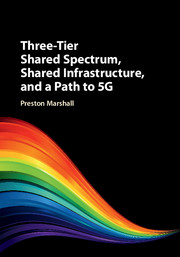Book contents
- Frontmatter
- Contents
- Acknowledgments
- Preface
- Part I Spectrum Sharing Background
- Part II Three-Tier Dynamic Spectrum Models
- Part III Components of a Three-Tier Architecture
- Part IV Protection Processes for Incumbents and Peers
- Part V Example Use of Three-Tier Spectrum: Use of the 3.5 GHz CBRS Band in the USA
- Part VI Future Bands, Network Services, Business Models, and Technology
- 15 Potential Services and Business Models Enabled by Three-Tier Spectrum
- 16 Candidate Incumbent Bands for Three-Tier Spectrum Sharing
- 17 From Shared Spectrum, to Shared Infrastructure, to a New Model of 5G
- 18 Future Actions to Deploy More Three-Tier Spectrum Bands and Nations
- 19 Alternatives to Three-Tier Operation
- 20 Conclusions and a Look Ahead
- Part VII Appendices
- Index
- References
15 - Potential Services and Business Models Enabled by Three-Tier Spectrum
from Part VI - Future Bands, Network Services, Business Models, and Technology
Published online by Cambridge University Press: 30 August 2017
- Frontmatter
- Contents
- Acknowledgments
- Preface
- Part I Spectrum Sharing Background
- Part II Three-Tier Dynamic Spectrum Models
- Part III Components of a Three-Tier Architecture
- Part IV Protection Processes for Incumbents and Peers
- Part V Example Use of Three-Tier Spectrum: Use of the 3.5 GHz CBRS Band in the USA
- Part VI Future Bands, Network Services, Business Models, and Technology
- 15 Potential Services and Business Models Enabled by Three-Tier Spectrum
- 16 Candidate Incumbent Bands for Three-Tier Spectrum Sharing
- 17 From Shared Spectrum, to Shared Infrastructure, to a New Model of 5G
- 18 Future Actions to Deploy More Three-Tier Spectrum Bands and Nations
- 19 Alternatives to Three-Tier Operation
- 20 Conclusions and a Look Ahead
- Part VII Appendices
- Index
- References
Summary
Introduction
Although much of the emphasis in the discussion of three-tier has been focused on spectrum sharing, the innovation will arise from a shared band and a shared technology that is usable by both traditional mobile operators, and non-operators, such as venues, enterprises, and even residences.Wireless Fidelity (Wi-Fi) created a common “Lingua Franca” among a wide range of deployers (mobile operators, residences, enterprises, venues, etc.), but the technology partitioned service quality, security, assured connectivity, and other highly desirable, and often necessary features, Assured quality was only available (or at least promised) through mobile operator technology and services. The use of the three-tier common band removes this partitioning between services, and can enable all wireless suppliers to offer identical technology, and equivalent, or differentiated, services.
Spectrum policy discussions tend to focus on the impact of spectrum regimes on band usage and technology. It is perhaps even more important to examine the impact of spectrum policy on the cycle of innovation. Wireless is facing a challenge to double bandwidth every year. Yet the current architecture took from five years to decades to deploy, little new spectrum is available, and the technology is approaching the theoretical link capacity asymptotically. In situations where linear advances are not adequate, innovation is essential.
From an economic perspective, we have learned certain truths. One of them is that domestic markets strongly support, and often lead to, leadership in international markets. Europe led national deployment of Global System for Mobile Communications (GSM), and ended up dominating handsets for a decade. The United States of America (USA) created the first unlicensed band, and US companies dominate much of the Wi-Fi industry.
This section will have an emphasis on mobile wireless services, since this is the major source of new spectrum demand. However, the same rationales as presented here should be applicable to new spectrum uses that emerge in the “post-cellular” world, as that evolves! This includes wireless fixed services, as well as fully integrated wireless fixed/mobile services, such as contemplated in 5G.
- Type
- Chapter
- Information
- Publisher: Cambridge University PressPrint publication year: 2017



